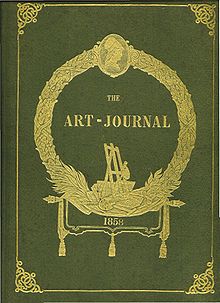The Art Journal
 Cover of a bound volume of The Art Journal from 1858 | |
| Categories | Victorian art |
|---|---|
| Publisher | Hodgson & Graves; Samuel Carter Hall; George Virtue |
| First issue | 15 February 1839 |
| Final issue | 1912 |
| Country | United Kingdom |
| ISSN | None |
| OCLC | 1514293 |
The Art Journal, published in London, was the most important Victorian magazine on art. It was founded in 1839 by Hodgson & Graves, print publishers, 6 Pall Mall, with the title the Art Union Monthly Journal (or The Art Union), the first issue of 750 copies appearing 15 February 1839.
History
Hodgson & Graves hired Samuel Carter Hall as editor, assisted by James Dafforne. Hall soon became principal proprietor, but he was unable to turn a profit on his own. The London publisher George Virtue then purchased into Hall's Art Union Monthly Journal in 1848, retaining Hall as editor. Virtue renamed the periodical The Art Journal in 1849.[1]
In 1851, Hall's engravings, 150 pictures from the private collection of the Queen and Prince Albert, were featured in The Art Journal as the "Great Exhibition of 1851". Though this feature was popular, the publication remained unprofitable, forcing Hall to sell his share of the journal to Virtue, while staying on as editor. In 1852, the journal finally turned a profit.[1][2]
As editor, Hall exposed the profits that custom-houses were earning on the import of Old Masters, and showed how paintings were manufactured in England. The Art Journal became noted for its honest portrayal of the fine arts, but its opposition to fake and mis-attributed Old Masters, such as Raphael or Titian, depressed the market in such works.
The early issues of the magazine strongly supported the artists of The Clique and after 1850 it became associated with opposition to the emerging Pre-Raphaelite Brotherhood (PRB), which Hall considered to be a reactionary movement. Its articles attacked the PRB and its supporter John Ruskin.[2][3]
After Hall's retirement in 1880, the journal changed its position, and faced strong competition from the Magazine of Art and the changing public taste influenced by Impressionism. It was in the end unable to retain its position and ceased publication in 1912. An American edition of The Art Journal was published in New York from 1881 to 1887 by Patterson and Neilson.
The publication has been referred to, at various times, as London Art Journal and Art-journal.
Editorship
| Editor's name | Years |
|---|---|
| Samuel Carter Hall | 1839–1880 |
| Marcus Bourne Huish | 1881–1892 |
| David Croal Thomson[4] | 1892–1902 |
Contributors
The Art Journal's most notable essayists included Ralph Nicholson Wornum, Thomas Wright, Frederick William Fairholt, Edward Lewes Cutts, and Llewellynn Jewitt.[2] Richard Austin Artlett supplied a long series of engraved plates of sculpture.[5]
References
- ^ a b "Original Drawings by W. H. Bartlett". Retrieved 5 March 2008.
- ^ a b c Stephen, Leslie; Lee, Sidney, eds. (1890). . Dictionary of National Biography. Vol. 24. London: Smith, Elder & Co. p. 88. OCLC 2763972.
- ^ Landow, George P. (July 1999). "The Art-Journal, 1850-1880: Antiquarians, the Medieval Revival, and The Reception of Pre-Raphaelitism". "This article originally appeared in The Pre-Raphaelite Review 2 (1979), 71-76.". victorianweb.org. Retrieved 4 March 2008.
- ^ "Thomson, David Croal". Who's Who,. 59: p. 1741. 1907.
{{cite journal}}:|pages=has extra text (help)CS1 maint: extra punctuation (link) - ^ Stephen, Leslie, ed. (1885). . Dictionary of National Biography. Vol. 2. London: Smith, Elder & Co.
